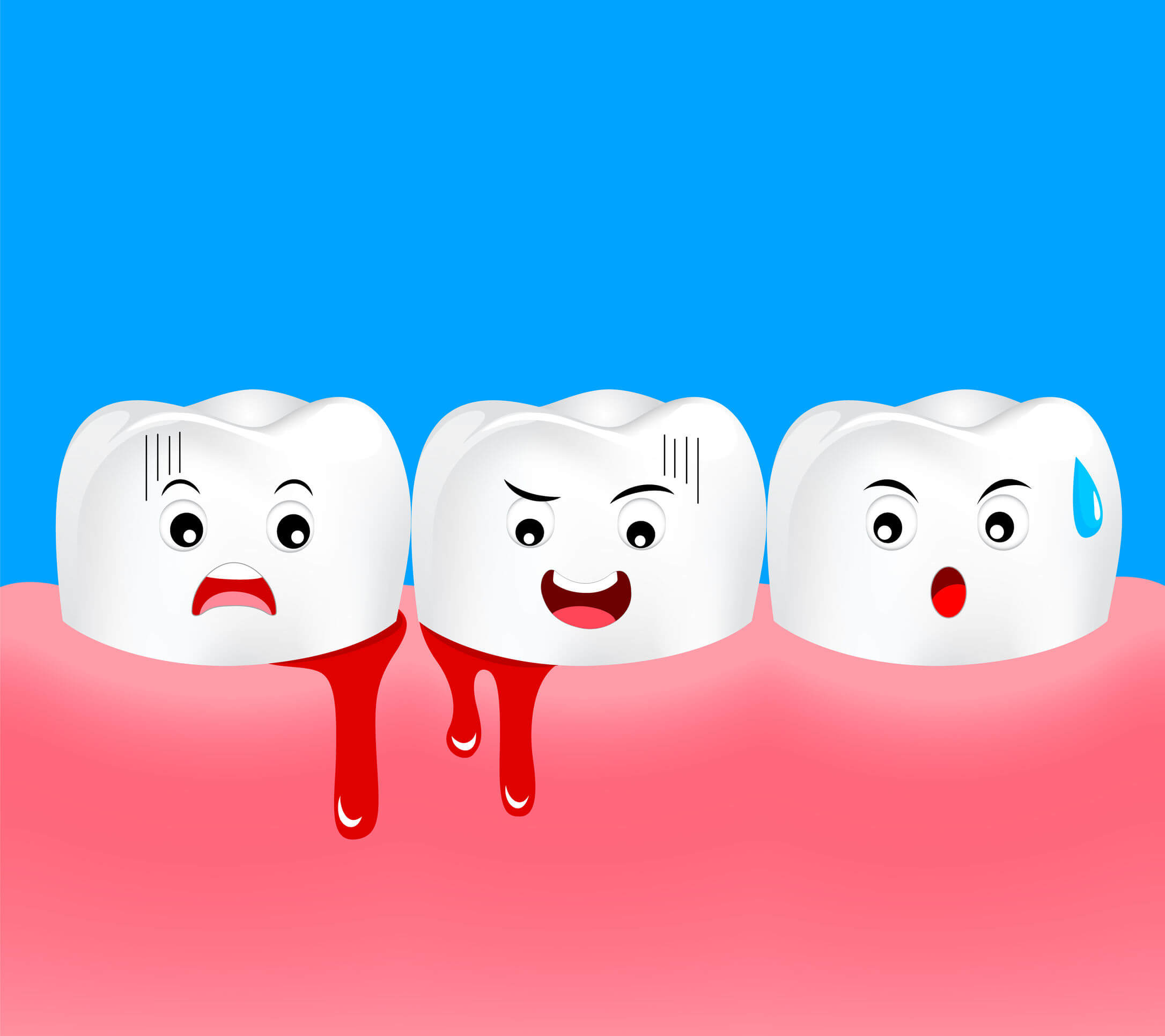Inflamed Gums in Children: Symptoms, Causes, and Treatment

Many people associate inflamed gums with a disease that’s typical in adults, but the truth is that it can also affect children. Keep reading to find out what the symptoms of this gum problem are, why it appears during childhood, how it’s treated, and what you can do to avoid it.
Symptoms of inflamed gums in children
The normal appearance of the gums is pink, without swelling, and with well-defined edges around the teeth. Being attentive and paying attention to the thickness and color of your child’s gum tissue will allow you to recognize if something’s wrong.
Inflamed gums (or gingivitis) in children are characterized by some particular symptoms. Here are the most relevant ones:
- Redness: The gums appear bright red and shiny.
- Edema: Inflammation of the gums in children causes an increase in the size of the tissue, which looks swollen and the edges surrounding the teeth lose their shape.
- Bleeding: The gingival tissue bleeds during tooth brushing and in more advanced cases, it occurs at the slightest friction or during eating.
- Bad breath: The accumulation of bacterial plaque in the mouth causes bad odor.
- Sensitivity: Children may complain of sensitivity when consuming certain very cold or very hot foods. Also, during tooth brushing.
- Loose tooth sensation: The child may feel that their teeth are separated or that the gums are moving.
- Abscesses: In the more advanced stages, gingivitis can be complicated by infections that cause abscesses. These are collections of pus in the thickness of the gum tissue.

Causes of gum inflammation in children
The main origin of gum inflammation in children lies in poor oral hygiene. When bacteria and food debris aren’t removed properly by brushing and flossing, a sticky film forms on the tooth surfaces, which is known as bacterial plaque.
Minerals in the mouth can calcify this film and turn it into tartar. This permanent accumulation of bacterial plaque and tartar on the gingival tissue causes irritation and consequent inflammation of children’s gums.
There are situations in the mouth of young children that can make dental hygiene difficult and predispose little ones to the appearance of gingivitis. For example, untreated caries cavities and crowded teeth favor the retention of bacteria and plaque.
Inflammation of the gums in children can also be associated with the period of tooth replacement. Many times, when a baby tooth is loose, the sensitivity causes neglect in the hygiene of the area. With this appears redness, bleeding, inflammation, and other discomforts in the gum.
Apart from those mentioned, there are other less frequent causes that can produce inflammation in children’s gums:
- Infections: Some oral infections, such as herpetic gingivostomatitis or candidiasis, can cause inflammation of the gums in children. They’re associated with other symptoms that complete the clinical pictures.
- Use of drugs: The use of some drugs can cause an increase in volume and a change in the shape of the gingival tissue. For example, anticonvulsant drugs such as phenytoin.
- Hormonal changes: The hormonal changes associated with puberty can cause gingival inflammation. Many times, in addition, there’s a neglect of hygiene habits, which aggravates the situation.
Treatment of gum inflammation in children
Treatment of gum inflammation in children is simple and convenient. It consists of improving dental hygiene to eliminate and control the bacterial plaque that causes the problem. This can be accomplished in two ways: At home and at the dentist’s office.
Home dental care
Treating gum inflammation in children requires adults to take charge of the problem. When symptoms of gingivitis are detected, it’s important to start with rigorous and adequate dental hygiene to contribute to the resolution of the disorder.
It’s important for parents to take charge of their children’s dental hygiene and make sure that all sides and surfaces of all teeth are well brushed.
In addition, emphasis should be placed on sanitizing the area where the teeth and gums meet. Gentle but concise movements should be made, moving from the gum towards the dental crown.
Brushing should last at least two minutes and should be done after every meal. Using fluoride toothpaste in doses appropriate for the age of the child helps to control bacterial plaque.
Flossing is also important. It allows cleaning of the interdental area, where the toothbrush can’t reach.

Professional treatment
When detecting any of the symptoms that make you suspect that something is wrong with your child’s gums, the first thing to do is to seek professional help. Seeing a pediatric dentist will help diagnose the problem, identify the cause, and seek a timely solution.
Regular dental checkups are also key. Sometimes, it may seem that everything’s going well in children’s mouths, but some diseases are only visible to the experienced eyes of the dentist. Visiting a pediatric dentist every six months is recommended.
To treat gum inflammation in children, the dentist performs a professional dental cleaning. This is a simple and painless treatment through which bacterial plaque and tartar deposits are removed.
The professional also uses plaque disclosers to help the child and their parents identify bacterial plaque and the places where it accumulates. With this, patients will be able to visualize the problem and know where it will be essential to pay more attention.
The teaching and practice of proper dental hygiene is part of the advice that the professional provides to adults so that they can take care of their children’s oral health. Choosing the right toothbrush and toothpaste, what movements to make and how to floss are some of the aspects that the dentist will clarify.
Reinforcing dental hygiene measures at home is part of the treatment. The dentist may also recommend the use of mouthwash for a while to control bacterial proliferation.
Inflamed gums in children can be prevented
With a proper oral hygiene routine, inflamed gums in children can be avoided. Taking care of your child’s teeth cleaning from an early age, offering a healthy diet, and taking them to the pediatric dentist twice a year are crucial to keeping their mouth healthy.
Teaching children about the importance of taking care of their mouth is an essential step to prevent gingivitis and other oral diseases. Instilling healthy habits in children from an early age is the best way to take care of their health.
All cited sources were thoroughly reviewed by our team to ensure their quality, reliability, currency, and validity. The bibliography of this article was considered reliable and of academic or scientific accuracy.
- Sánchez-Pérez, L., Sáenz-Martínez, L., Alfaro Moctezuma, P., & Osorno Escareño, C. (2013). Comportamiento del apiñamiento, gingivitis, higiene oral, caries, flujo salival y bacterias en escolares de 8 y 10 años. Revista ADM, 70(2).
- Arela, C. B., Valdivia, S. M., & Alagón, S. C. (2019). Respiración bucal en el altiplano puneño y su relación con la salud gingival en niños de 6 a 12 años. REVISTA DE CIENCIAS NATURALES, 1(2), 76-85.
- Martín, M. E., & de Lértora, M. S. D. (2011). Prevalencia de enfermedad gingival en niños con denticion primaria. Revista de la Facultad de Odontología, 4(1), 19-28.
- Castro-Rodríguez, Y. (2018). Enfermedad periodontal en niños y adolescentes. A propósito de un caso clínico. Revista clínica de periodoncia, implantología y rehabilitación oral, 11(1), 36-38.
- Núñez Picado, B., & Ulate Jiménez, J. (2020). Eficacia en la remoción del biofilme dental con diferentes aditamentos durante la profilaxis dental en pacientes pediátricos. Odontología Vital, (32), 71-78.
- Herrera Sornoza, R. J. (2021). INFLUENCIA DE LOS CUIDADORES DE LA SALUD BUCAL DE NIÑOS Y NIÑAS ESCOLARES.
- Martínez, F. G., Acosta, M. D. C. G., Meden, L. K., Nakayama, H. D., & Mendieta, H. N. (2019). Control de la biopelícula dental en niños mediante una estrategia de motivación basada en el uso domiciliario de sustancia reveladora. Revista científica ciencias de la salud-ISSN: 2664-2891, 1(1), 39-45.